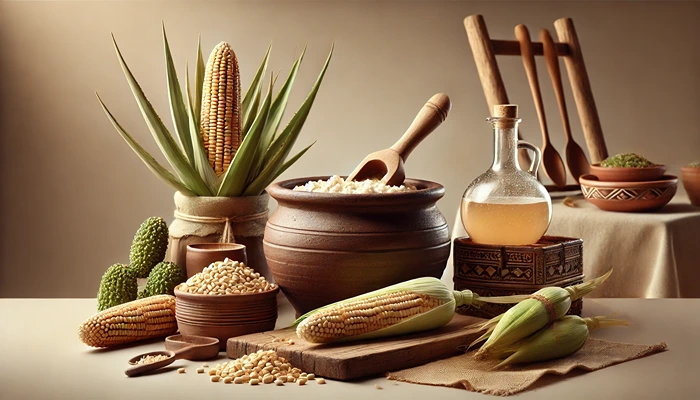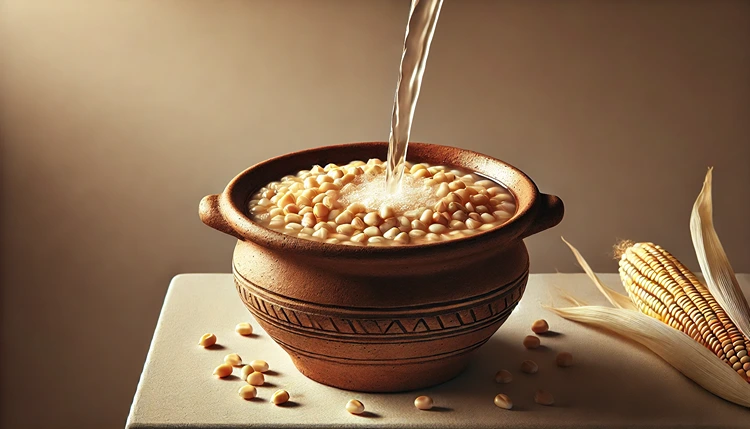The Aztecs were masterful in the kitchen, not just for their diverse ingredients but also for their unique cooking methods. One key technique they excelled in was fermentation. Fermentation methods in Aztec cooking allowed them to preserve food, enhance flavors, and even create beverages like pulque, a drink made from the fermented sap of the maguey plant.
Fermentation is an ancient technique that transformed food and drink across civilizations, and in the Aztec world, it was an essential part of their culinary culture. Whether you’re a history buff or a food enthusiast, exploring fermentation in Aztec cuisine provides a fascinating look into how this culture nourished its people. From drinks to preserved food, fermentation methods weren’t just practical—they were a way to turn the simple into the extraordinary.
What is Fermentation in Aztec Cooking?
Fermentation is the process by which natural bacteria or yeasts convert sugars into alcohol or acids. The Aztecs used fermentation primarily to preserve food and produce alcohol, but they also appreciated the depth of flavor it added to their dishes. This process was key for foods that needed to be stored for long periods, especially in a world without refrigeration.
The fermentation process involved local plants, fruits, and grains, with ingredients like maize (corn) and maguey playing pivotal roles. These fermented ingredients were then used to make a variety of dishes and drinks, from food staples to ceremonial beverages.
Helpful Hint:
Fermentation isn’t just about preservation—it enhances flavors and transforms textures, making it a creative method for modern cooking too. Try adding fermented elements to your meals for a burst of rich, complex taste.
How Did the Aztecs Use Fermentation?
The Aztecs used fermentation in various ways, and one of the most well-known products of this process was pulque. Pulque was made from the fermented sap of the maguey plant, a cousin to the agave plant. This drink was highly significant in Aztec culture, consumed during religious ceremonies and social gatherings.
Beyond pulque, fermentation was used to preserve vegetables, corn, and even grains, allowing them to last through long periods of scarcity. The process created pickled vegetables and other preserved items that were stored and eaten throughout the year.
What Ingredients Were Commonly Fermented?
The most common ingredients used in Aztec fermentation included:
- Maguey: The sap was fermented to make pulque.
- Maize: Corn was often fermented to make a type of sourdough.
- Vegetables: Various vegetables were pickled and preserved for long-term storage.
Fermentation Timeline for Aztec Foods and Drinks
| Ingredient | Fermentation Duration | End Product |
|---|---|---|
| Maguey Sap (Aguamiel) | 3-5 Days | Pulque |
| Maize (Corn) | 24-48 Hours | Nixtamalized Corn (for tortillas and tamales) |
| Savory Vegetables (e.g., Squash, Beans) | 1-2 Weeks | Pickled Vegetables |
Each ingredient served a unique role, whether to create nourishing food or important ceremonial drinks.
Why Was Fermentation Important in Aztec Cooking?
The importance of fermentation in Aztec cooking stemmed from both necessity and culture. On a practical level, fermentation allowed them to preserve food and create nutrition-dense meals. Corn, the backbone of the Aztec diet, was sometimes fermented to make it easier to digest and more nutritious.
But it wasn’t just about survival—fermentation methods in Aztec cooking had cultural and spiritual significance. Drinks like pulque were central to religious and social ceremonies, acting as a bridge between the mundane and the divine. To the Aztecs, fermentation was more than a culinary technique; it was an integral part of their way of life.
Fermentation and Aztec Beverages: The Case of Pulque
Pulque deserves a closer look, as it was perhaps the most significant fermented beverage in Aztec culture. Made from the sap of the maguey plant, this milky, slightly sour drink was consumed in large quantities during ceremonies. Fermenting the maguey sap was a labor-intensive process, but it was well worth it for the result—a drink that symbolized fertility and was believed to connect people with the gods.
How Was Pulque Made?
The process of making pulque involved collecting the fresh sap from the maguey plant, also known as “aguamiel” or honey water. This sap was allowed to ferment for several days, turning the natural sugars into alcohol. It required careful attention to timing and temperature to achieve the desired flavor and strength.
Traditional Pulque Recipe

Ingredients
- Fresh maguey sap (aguamiel)
- A clean, airtight container
Instructions
- Collect fresh sap from a maguey plant.
- Transfer the sap to a clean, airtight container.
- Allow the sap to ferment at room temperature for 3-5 days.
- Once fermented, serve chilled or at room temperature.
Notes
Pulque is best enjoyed fresh but can be refrigerated for up to a week after fermentation.
This process produced a drink that, while alcoholic, wasn’t too strong and had a slightly tangy, earthy flavor.
Fermented Foods in Aztec Cooking
Fermentation wasn’t just reserved for drinks in Aztec cuisine. Many foods were fermented to preserve them or enhance their flavor. These fermented foods were staples in Aztec households, providing sustenance during times when fresh food wasn’t readily available. The Aztecs knew that fermentation was an effective way to store food, but they also valued the flavors it developed.
How Was Corn Fermented?
Corn was one of the most important crops in Aztec society, and fermenting it was a common practice. The fermentation of corn, or nixtamalization, involved soaking the kernels in an alkaline solution, often made with limestone. This process not only preserved the corn but also made it more nutritious by unlocking niacin, an essential nutrient.
Once fermented, the corn was used to make a variety of foods, including tamales and tortillas. This fermentation process also gave the food a distinct sour flavor, which became a beloved part of Aztec cuisine.
Other Fermented Vegetables
Vegetables like squash, peppers, and beans were also fermented. The fermentation process was similar to modern pickling, where the vegetables were placed in a brine solution and allowed to sit for several days or weeks. This method preserved the vegetables and created complex, tangy flavors.
Fermenting vegetables was especially important for the Aztecs during colder months or times of scarcity. These preserved foods ensured they had a consistent source of nourishment.
Why Was Fermentation a Sustainable Practice?
Fermentation was a sustainable practice in Aztec cooking for several reasons. First, it allowed the Aztecs to make the most of their crops by extending the shelf life of foods that would otherwise spoil quickly. It also provided a way to use every part of a plant, reducing waste and maximizing food resources.
Additionally, fermentation required minimal resources. Unlike cooking methods that used firewood or other fuel sources, fermentation relied on natural processes. This made it an energy-efficient way to preserve food in a time when resources were precious.
Helpful Hint:
Want to reduce food waste at home? Try fermenting vegetables like cucumbers, carrots, or cabbage. It’s a great way to preserve your produce and add bold flavors to your meals!
How Does Fermentation Affect Nutrition?
One of the key benefits of fermentation methods in Aztec cooking was the nutritional boost it provided. Fermentation helps break down complex carbohydrates and proteins, making the food easier to digest. In the case of corn, fermentation increased the availability of niacin, which was essential for preventing diseases like pellagra.
Fermented foods also contain probiotics, the beneficial bacteria that support gut health. While the Aztecs might not have known about probiotics, they certainly understood that fermented foods were good for the body. Their diet, rich in fermented products, kept them healthy and nourished.
Fermentation in Modern Mexican Cuisine
Many traditional Mexican dishes that we know today have roots in Aztec fermentation methods. From the sourdough-like masa used for tortillas to the tangy pulque still enjoyed in certain regions, these ancient techniques have stood the test of time.
Today, fermentation is experiencing a resurgence in kitchens around the world. Chefs and home cooks alike are rediscovering the value of this ancient method for its ability to transform simple ingredients into flavor-packed, nutritious foods.
Bringing Fermentation into Your Kitchen
If you’re interested in trying fermentation at home, start with simple ingredients like vegetables or grains. There’s no need for fancy equipment—just clean jars, a little salt, and patience. You might be surprised at how easy it is to create fermented foods that are not only delicious but also packed with health benefits.
FAQs
Wrapping Up
Fermentation methods in Aztec cooking were vital to the preservation, flavor enhancement, and nourishment of their people. From creating pulque to fermenting maize and vegetables, the Aztecs mastered this ancient technique long before modern methods were developed. These methods not only allowed them to store food but also added rich, complex flavors to their cuisine, which still influences Mexican food today.
As fermentation continues to gain popularity in modern kitchens, it’s clear that the Aztecs were pioneers of this practice. By learning about their methods, you can bring some of this culinary wisdom into your own kitchen, enriching your meals with the vibrant flavors of fermentation.








